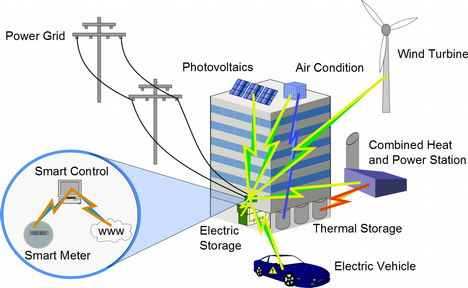SAMBA
Commercial buildings represent a tremendous amount of global energy use. Additionally, the increasing number of renewable power plants such as wind generators requires more and more balancing power to maintain electric grid reliability.
In future, smart buildings interact with the power grid to optimize the energy flows between them. A sophisticated operation of the building services represent a significant opportunity for energy efficiency, cost reduction, and stabilizing the smart grid. Intelligent algorithms will manage the energy storages and shut off loads with little impact on occupants. Cogeneration units, building integrated photovoltaic plants or even an electric fleet car can be used to supply the grid with additional power.
Research Objectives
The simulation and prediction of the future states and the thermal and electric energy flows is a key element to optimally operate the building services, while guaranteeing a high comfort to the users. Therefore, self-adapting building models are developed to reproduce the relevant building dynamics.
Based on the model predictions, supervisory optimal operation strategies for the building services are calculated in consideration of the variable boundary conditions such as ambient temperature or electricity tariffs.
Using the simulation framework, the selection and dimensioning of the building service components is performed optimally. In the case of a hardware failure, a model-based monitoring system guarantees the fast detection and replacement of the faulty component.
The new energy management system will be tested in a real building environment. The target is to reduce the building operating costs by 10% in a variable electricity tariff system.

